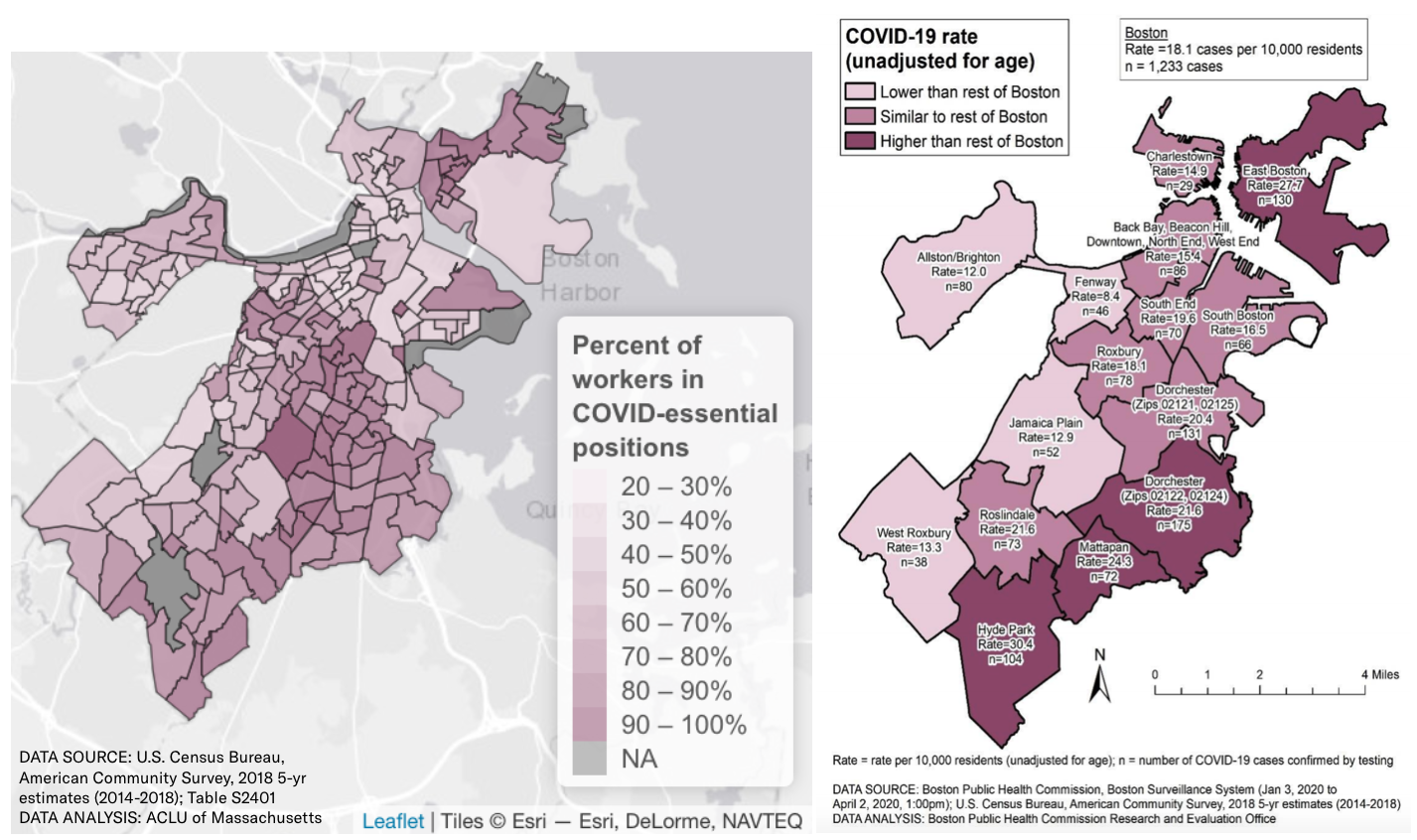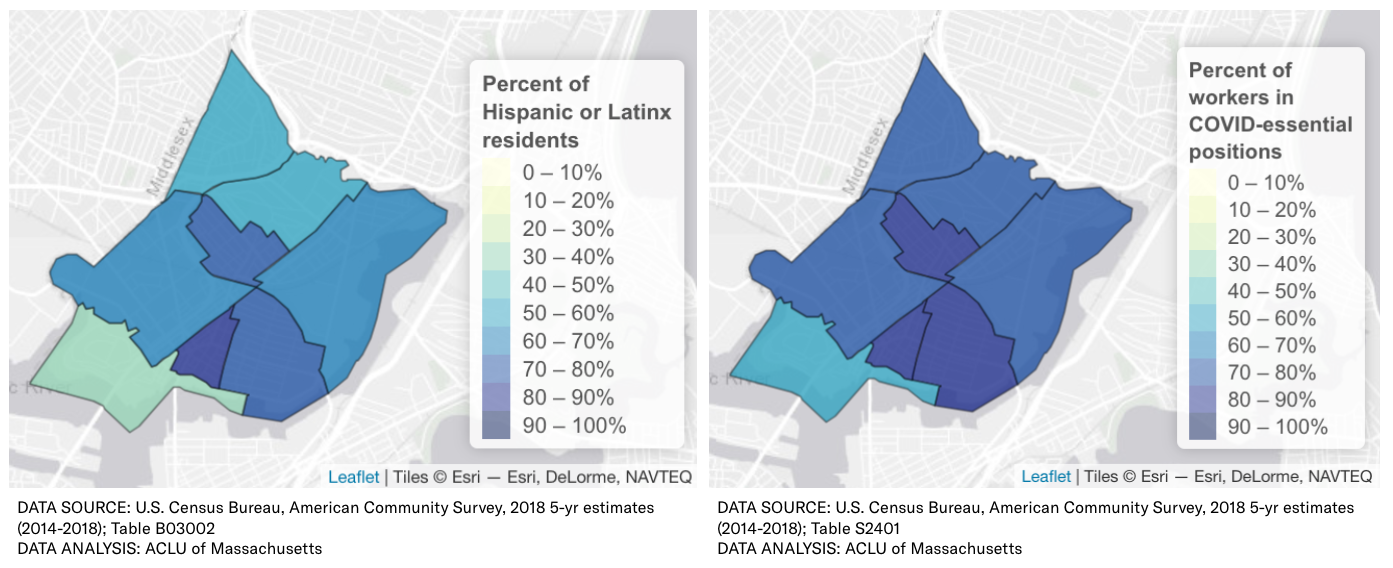Newly released data from the Boston Public Health Commission (BPHC) show that COVID-19 is present at higher rates in certain Boston communities, including Hyde Park, Mattapan, Dorchester, and East Boston. Analysis presented here by the ACLU of Massachusetts compares BPHC’s findings to census data, in order to better understand how the COVID-19 pandemic is affecting Boston’s essential workers and communities of color.
COVID-19 Cases Concentrated Among Boston’s Essential Workers
According to the census data, the Boston neighborhoods most impacted by COVID-19 are co-located with the highest proportions of essential workers in the city.
Using data from the U.S. Census 2018 American Community Survey (ACS), we mapped the proportion of workers across Boston who are employed in “COVID-essential” occupations. We defined “essential” occupations to include the following:
- Healthcare practitioners and technical occupations
- Construction and extraction occupation
- Farming, fishing, and forestry occupation
- Installation, maintenance, and repair occupation
- Material moving occupation
- Production occupation
- Transportation occupation
- Office and administrative support occupation
- Sales and related occupation
- Building and grounds cleaning and maintenance occupation
- Food preparation and serving related occupation
- Healthcare support occupation
- Personal care and service occupation
- Protective service occupations

COVID-essential workers are most concentrated in Dorchester, Roxbury, and East Boston – the same neighborhoods where the virus is present at its highest rates.
COVID-19 Cases Concentrated in Boston’s Black & Brown Neighborhoods
Similarly, the areas with the most COVID-19 cases align with Boston’s communities where people of color make up a majority of the population.

Communities like Hyde Park, Mattapan, and Dorchester where over 50 percent of the population is non-white (including African American, Hispanic or Latinx, Asian, Native American, Multiracial, or any racial category other than “White Alone”) are again the same communities with the highest rates of COVID-19.
Latinx-Majority Chelsea Hit Hard
As this crisis evolves, more details are coming into focus that show how already-vulnerable communities are those hardest hit by the virus.
As of April 7th, the city of Chelsea had 315 COVID-19 cases in a population just over 40,000. This translates to a rate of about 79 cases per 10,000 residents – over four times higher than the rate in neighboring Boston of 18 cases per 10,000 residents, as reported by the BPHC.
On Monday evening, Massachusetts General Hospital’s Chief Equity and Inclusion Officer, Dr. Joseph Betancourt, reported that 35-40 percent of the COVID-19 patients being treated at Mass. General were Hispanic or Latinx.
Some heavy news: MGH official tells @WBUR & @elplanetaboston that 35-40% of COVID patients are Latino — that’s up from ~9% Latino patients before the crisis. That could be a 400% increase, an “absolute epidemic” in ‘hoods like Chelsea, says Dr. Joseph Betancourt.
— Simón Ríos (@simonfrios) April 6, 2020
In an interview with WBUR, Betancourt mentioned that the outsized effect Chelsea is experiencing could be due to a number of factors, including increased rates of co-habitation and high proportions of residents working in jobs “where social distancing is not possible.”
Indeed, our analysis of 2018 ACS data shows that 79.8 percent of all workers in Chelsea are in COVID-essential positions. In some parts of Chelsea, over 80 percent of the employed population work in occupations that are deemed essential during the on-going crisis:

And even within Chelsea, census tracts with the highest proportion of Hispanic or Latinx residents align exactly with the tracts containing the greatest percentage of workers employed in essential jobs.
As editorial writer Marcela García states in her recent Boston Globe piece about Chelsea, “Not only are these immigrants — mostly Latino, many of them here without legal status — the most economically vulnerable, but a high proportion of them already have limited access to health care and other public support networks. Working from home is a privilege that they simply don’t have.” She describes how the COVID-19 outbreak is acting as a “great revealer,” bringing to light systemic inequalities that have plagued minoritized and working-class communities for centuries.
Ultimately, it is communities like Chelsea, with a very high proportion of both COVID-essential workers and residents of color, that are suffering disproportionately in this pandemic. Ironically, a major cause of their increased hardship is the irreplaceable role they play in supporting the continued functioning of all of society, by working essential service jobs.
This is exactly why the ACLU of Massachusetts and other advocacy organizations are pushing for legislative, executive, and judicial action to protect immigrants and working people. While the federal stimulus package passed by Congress in March is a start, it does not go far enough to establish the comprehensive social and economic protections – or the robust data collection practices – required to support vulnerable communities across Massachusetts today.
Our mayors, governors, and representatives must step up. Last week, the ACLU of Massachusetts called on the state Department of Public Health to center equity in its response to the crisis. We must record the race and ethnicity of those receiving tests and treatment for COVID-19, so as to better understand how the virus affects different communities differently. We must ensure that our first responders—including not just EMTs and other healthcare personnel, but also grocery store employees, delivery workers, and public transit operators—have the personal protective equipment (PPE) they need, and have priority access to testing.
The stakes have seldom been higher to get it right on equity. Our leaders must act now in order to save the lives of those working to protect and support us all.
Interested programmers can find the R code used to create these maps on Github.
Edit: A previous version of this blog cited the total percent of essential workers in Chelsea to be 76.9 percent. That number was calculated in error, and has been updated to 79.8 percent.
